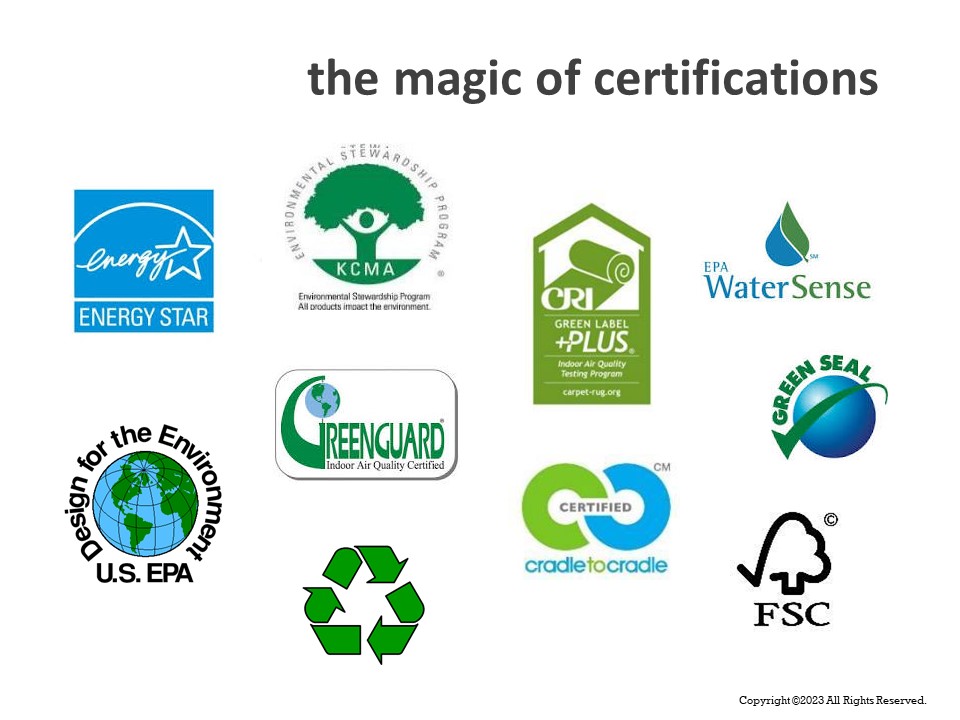
In our quest for healthier, more sustainable living, the choices we make regarding the products we buy play a significant role. However, with an abundance of options claiming to be healthier and/or environmentally friendly, it’s essential to navigate through the clutter and make informed decisions. This is where green product certifications come into play, providing valuable guidance in our pursuit of a greener lifestyle. Let’s break down the key aspects of green certifications and how they can help us make better choices.
Certifications serve as guiding lights, particularly in green building projects. They assure consumers that a product has undergone rigorous testing and verification by impartial entities. It’s not just about what you buy but also who you buy it from and where it comes from that should influence our product choices. One notable certification is the B Corp certification, indicating a company’s commitment to benefiting society rather than solely pursuing profits. With over 7000 certified companies, it’s easier than ever to find sustainable options from brands dedicated to social and environmental responsibility.
To distinguish truly sustainable products from greenwashing, look for independent third-party certifications such as FSC for wood and paper products, GreenGuard for lower off-gassing, and GreenSeal for healthier, more sustainable choices. These certifications offer tangible proof of a product’s sustainability claims and empower consumers to make informed decisions.
Green labels are there to show us that there has been third-party certification for a product, an assembly, or even an entire building. They are proof that something has been certified, and truly is what it claims to be. If the third-party was not there, anyone would be able to do or say whatever they wanted to, about any product.
When it comes to appliances, fixtures, lighting, plumbing, and finishes, there are numerous “smarter” options available to save resources like energy, water, and materials while ensuring a healthy indoor environment. Certifications like ENERGY STAR, WaterSense, and Green Guard guide consumers toward energy-efficient, water-saving, and low-toxin products, respectively, promoting sustainability without compromising performance.
You can green your entire home, taking one small step at a time. Some steps to take in that direction are:
The US Green Building Council has LEED (Leadership, Energy, and Environmental Design). It is available for homes. There is also the National Green Building Standard, the National Association of Home Builders (NAHB), and local and regional green building standards, like Green Build Texas, Green Build Washington, and Earthcraft Homes in the South-East. There are also energy-efficient only certifications, like Energy Star, for homes and new homes. Home Energy Ratings Score (HERS) is a home energy ratings score index or a scale of energy efficiency which assesses the energy usage and relates it to an existing home.
The internet is a valuable resource for finding sustainable and eco-friendly products. Numerous websites established by reputable non-profit organizations offer insights into sustainable products and provide guidance on making greener choices. By leveraging these platforms, consumers can make informed decisions for a more environmentally responsible lifestyle.
Greenwashing, the deceptive practice of marketing products as environmentally friendly when they’re not, has been a growing concern. To combat greenwashing, certifications serve as a shield, offering assurance that a product meets rigorous sustainability standards. By prioritizing certified products, consumers can avoid falling victim to deceptive marketing tactics and support brands genuinely committed to sustainability.
Green labels extend beyond consumer goods to various aspects of life, including home building and renovation. Certifications like LEED, National Green Building Standard, and Energy Star for homes provide guidelines for creating sustainable living spaces. By adhering to these standards, homeowners can reduce their environmental footprint and contribute to a more sustainable future.
You can green your entire home, one small step at a time. Certifications like Energy Star, WaterSense, and Green Guard offer guidance on choosing sustainable products for electrical upgrades, plumbing fixtures, and woodwork. Additionally, concepts like Cradle to Cradle promote efficient resource use in both products and processes, furthering the transition to a circular economy.
In conclusion, green product certifications play a crucial role in guiding consumers toward more sustainable choices. By understanding the significance of certifications, identifying reliable labels, and leveraging online resources, consumers can navigate the complex landscape of green products with confidence. By prioritizing certified products and avoiding greenwashing, we can collectively work towards a greener, more environmentally sustainable future.
Get 5 Myths of Green Homes to reveal the true value that is commonly overlooked in virtually every home!
At Green Home Coach, helping you to create and discover healthier, more comfortable homes is what I do. I work with home professionals – designers, builders, realtors, and more; home owners and dwellers … just about anyone that works with a home in some way.
© Green Home Coach 2024 | An Oakes Creative House Site | Privacy Policy | Terms of Service
Photography by SLPhotography | Home page image provided by Chelsey Seaton Photography